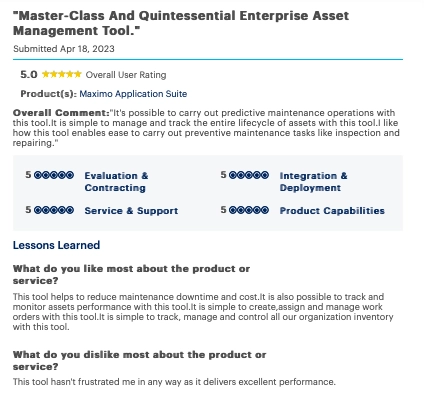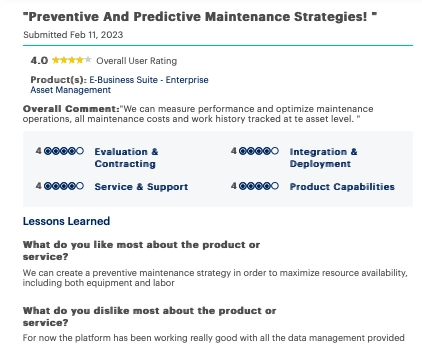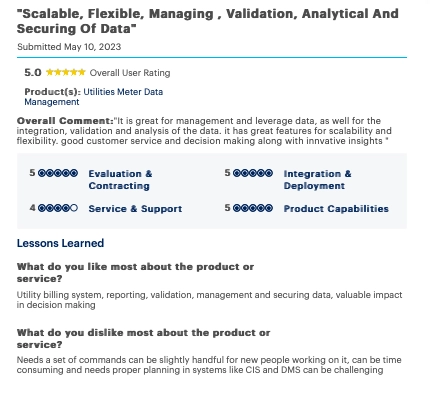According to the US Energy Information Administration statistics, ~75% of U.S. households installed smart meters which serve as the foundation for smart grids. 1 .
Smart grid solutions can improve system reliability, monitor energy production and manage energy storage. Yet, the smart grid system landscape is complicated, including diverse technologies.
Check out our comprehensive benchmark to outline these technologies and identify top smart grid solutions:
Top Smart Grid Solutions and Software
The table shows smart grid solutions, sorted by the number of reviews they received in their respective categories except sponsors which are listed at the top with their links. The solutions are divided into two main categories:
- Advanced Metering Infrastructure (AMI) Tools provide a complete smart meter solution.
- Complementary Tools includes workload automation (WLA), customer information systems, and other infrastructure management tools like meter data management.
Top 9 Complementary smart grid solutions
1. RunMyJobs
RunMyJobs by Redwood (RMJ) specializes in workload automation (WLA) and job scheduling, providing solutions to streamline and automate complex workflows for utilities. It can be used to automate utility processes, optimize task scheduling, and improve operational efficiency for smart grids. RunMyJobs by Redwood delivers:
- Smart grid management covering the spectrum of operations from grid monitoring to grid-to-grid interactions. This approach addresses challenges associated with diverse grid components.
- Automation of grid operations can streamline tasks like load balancing, fault detection, and response mechanisms, ensuring optimal resource utilization that can contribute to the overall reliability of the smart grid.
- Real-time monitoring and control empowers grid operators with real-time insights into grid performance, energy consumption patterns, and equipment status. This capability facilitates prompt decision-making, allowing operators to respond swiftly to grid events and fluctuations, ensuring the stability and resilience of the smart grid.
- Connectivity with SAP solutions: RunMyJobs by Redwood features prebuilt connectors for S/4HANA, BTP, and other SAP solutions, facilitating integration. This can enable speed to market and help businesses preserve a clean SAP core (i.e. the integrity of the existing SAP infrastructure).
- Security measures include encryption and a single-tenant architecture to safeguard sensitive grid data and fortify the overall cybersecurity posture of the smart grid infrastructure, addressing the evolving threat landscape.
2. IBM Maximo for Utilities
IBM Maximo for Utilities, an Enterprise
agement (EAM) solution crafted for utility companies, excels in smart grid optimization with unique strengths:
- Comprehensive asset lifecycle management: Maximo ensures optimal performance across the asset lifecycle, covering equipment, infrastructure, and facilities crucial for smart grids (See Figure 2).
- Preventive maintenance excellence: Prioritizing preventive maintenance, Maximo reduces equipment failures, enhancing reliability and minimizing downtime in smart grid operations (See Figure 2).
- Resource optimization: Designed for efficient resource utilization, Maximo contributes to smart grid operational efficiency, optimizing equipment, infrastructure, and facility usage.
- Real-time insights and predictive analytics: Maximo provides real-time insights and predictive analytics, empowering proactive decision-making and issue response in smart grid management.
- Mobile accessibility: Maximo’s mobile accessibility enables on-the-go monitoring of smart grid assets, enhancing flexibility and responsiveness.
- Robust work order management: With robust work order management, Maximo streamlines processes like load balancing and fault detection, contributing to smart grid reliability.
- Integration capabilities: Integrating with existing systems, Maximo ensures a smooth integration process, preserving infrastructure integrity in the smart grid ecosystem.

3. Oracle Enterprise Asset Management
Oracle Enterprise Asset Management (EAM) proves instrumental in smart grid optimization, standing out for its unique strengths:
- Comprehensive asset management: Oracle EAM excels in end-to-end asset management, covering work order management, maintenance planning, and asset performance monitoring crucial for smart grids.
- Oracle ecosystem integration: Oracle EAM integrates with Oracle’s broader ecosystem, providing a holistic approach to enterprise asset management. This integration enhances interoperability within the smart grid ecosystem.
- Predictive maintenance: Oracle EAM stands out for its predictive maintenance capabilities, empowering utilities to proactively address potential issues. This proactive approach reduces downtime and extends the lifecycles of smart grid assets, contributing to increased reliability (See Figure 3).

4. Efluid
Efluid by efluid SAS, a Customer Information System (CIS) solution, that helps improving utility customer-related processes by managing customer data and supporting customer interactions.
5. Umax by Itineris
Umax by Itineris, a Customer Information System (CIS) solution designed for utilities, elevates customer engagement and billing processes, offering:
- CIS functionalities can deliver end-to-end capabilities for customer engagement and billing, encompassing meter-to-cash processes and customer relationship management.
- Customer experience management focuses on providing utilities with insights into customer interactions and optimization opportunities for the billing processes.
6. Utilities Meter Data Management by Oracle
Utilities Meter Data Management by Oracle, a Meter Data Management (MDM) solution, centralizes and manages metering data with a focus on scalability and integration. The tool offers:
- Centralized meter data repository: Oracle can provide a centralized repository for meter data, streamlining data management processes crucial for accurate billing, analytics, and reporting within utility operations (See Figure 4).
- Enhanced data accuracy: Utilities Meter Data Management enables utilities to enhance data accuracy, contributing to reliable billing and supporting the integration of advanced metering infrastructure, optimizing grid operations.

7. Fluentgrid MDM solution
Fluentgrid MDMS, a Meter Data Management (MDM) solution, prioritizes efficient meter data management and analysis for utilities with unique features, such as:
- Data-related functionalities: Fluentgrid provides functionalities for data validation, estimation, and analytics, ensuring comprehensive management and analysis of meter data for utility operations.
- Optimizing metering operations: The solution supports utilities in optimizing metering operations by managing and improving billing accuracy and overall grid performance.
- Real-time data processing: Fluentgrid MDMS can process data in real-time.This contributes significantly to the effective management of metering infrastructure.
8. Survalent ONE ADMS by Survalent Technology
Survalent ONE ADMS by Survalent Technology, an Advanced Distribution Management System (ADMS), concentrates on grid control and optimization for utilities, emphasizing real-time capabilities and comprehensive situational awareness, like:
- Real-time monitoring and managing: Survalent ONE ADMS can monitor, control, and optimize distribution networks, helping utilities gain actionable insights to their operations (See Figure 5).
- Integration of diverse devices: The solution supports the integration of diverse grid devices, smart meters, and renewable energy sources, ensuring adaptability to modern utility infrastructures.
9. ACS PRISM ADMS by Advanced Control Systems
ACS PRISM ADMS by Advanced Control Systems, an Advanced Distribution Management System (ADMS), prioritizes grid optimization and distribution network performance with a focus on real-time capabilities and adaptive algorithms:
- Real-time monitoring, analytics, and control: ACS PRISM ADMS can help with real-time monitoring, analytics, and control of distribution grids, providing utilities with immediate insights into grid operations.
- Addressed management issues: The solution focuses on fault detection, outage management, and integration of distributed energy resources (DERs), addressing key challenges in modern distribution network management.
- Scalability and responsiveness: ACS can adapt to changing environment and ensures reliable and qualified service to utility providers (See Figure 6).
Top 2 advanced metering infrastructure providers
10. Siemens
Siemens, a prominent provider of Advanced Metering Infrastructure (AMI) solutions, takes the lead in revolutionizing utilities’ metering capabilities, optimizing smart grid operations:
- End-to-end infrastructure: Siemens delivers end-to-end AMI solutions, integrating advanced metering, communication, and data management functionalities.
- Two-way communication: Siemens can provide secure and efficient two-way communication between utilities and meters.
- Real-time data collection: The solution enables utilities to collect real-time data, optimizing grid operations and empowering consumers with valuable insights into energy usage. This contributes significantly to building a sustainable and responsive grid (See Figure 7).
11. Itron
Itron, a specialized provider of Advanced Metering Infrastructure (AMI) solutions, optimizing grid performances by providing:
- Secure and scalable systems: Itron delivers secure, scalable, and interoperable AMI systems, ensuring enhanced grid visibility and optimal resource management for utilities.
- Real-time data collection: The solution can collect real-time data, enabling utilities to make informed decisions. This contributes to improved billing accuracy and engages customers in effective energy management, creating a more responsive and customer-centric grid.
Types of smart grid solutions and technologies
Complementary smart grid tools
These tools complement smart grid solutions by automating, orchestrating and managing smart grid operations.
Workload automation and job scheduling software
Workload automation (WLA) tools contribute to smart grid technology by enhancing operational efficiency, automating tasks, and optimizing grid performance. WLA companies deliver smart grid solutions that address the limitations of traditional power grids by:
- Enabling decentralized power generation through microgrids
- Developing complex distribution systems or allying with these distribution system operators (DSOs)
- Increasing data collection capabilities
- Reducing energy costs
- Ensuring hybrid offerings, combining renewable energy sources with traditional sources like coal and gas.
Explore WLA use cases and compare top workload automation tools.
Enterprise asset management
Enterprise Asset Management (EAM) is an integral utility asset management to systematically oversee the entire lifecycle of physical assets within smart grids, optimize performance, minimize downtime, and align maintenance strategies with utility business objectives.
EAM software facilitates comprehensive planning, procurement, operation, maintenance, and retirement processes, ensuring efficient asset utilization, reduced operational risks, extended lifespan, and enhanced grid reliability while contributing to sustainable and efficient asset management practices.
CIS in utilities
CIS in utilities refers to a comprehensive software system designed to manage customer-related information and processes within the utility sector. It can streamline and optimize customer interactions, ensuring accurate billing, timely responses to inquiries, and improved overall customer satisfaction.
CIS integrates data from various touchpoints, allowing utilities to maintain a centralized view of customer information. Key features often include billing and invoicing, account management, and support for customer communication.
Master data management (MDM)
Master Data Management (MDM) in the context of smart grids involves the strategic management of critical data assets within an organization. It focuses on creating and maintaining a single, consistent, and accurate version of master data across the enterprise. Master data includes information about assets, customers, locations, and other essential entities.
MDM ensures data quality, integrity, and coherence, enabling utilities to make informed decisions based on a reliable foundation. This subcategory of smart grid technology supports interoperability between different systems, facilitates data sharing, and enhances the overall efficiency of data-driven processes.
Advanced Distribution Management System (ADMS)
An ADMS is a sophisticated software solution designed to enhance the real-time monitoring, control, and optimization of distribution networks within the utility sector. ADMS integrates functionalities of distribution management systems (DMS) and outage management systems (OMS), offering a holistic approach to grid operations.
It provides utilities with comprehensive situational awareness, facilitating quick responses to faults, outages, and changes in demand. Key features often include fault detection, load balancing, renewable energy integration, and adaptive control strategies. ADMS contributes to grid resilience, reliability, and the efficient management of distributed energy resources.
Advanced metering infrastructure (AMI) providers
AMI offers a holistic solution tailored for the implementation and management of advanced metering within smart grids, addressing both software and hardware components. These solutions incorporate the deployment of intelligent meters, offering real-time insights into energy consumption.
With AMI, smart grids facilitate bidirectional communication between utilities and consumers, enhancing precision in billing, enabling remote disconnect/reconnect functionality, and facilitating in-depth analysis of energy usage patterns.
Other critical smart grid technologies with examples
Smart Grid IoT
It refers to the integration of IoT technologies into energy infrastructure, enabling real-time data collection, communication, and automated decision-making to optimize electricity generation, distribution, and consumption. Smart grid IoT can enable:
- Performance improvement of energy systems through real-time monitoring and optimization.
- Reduced downtime by improving rapid responses to disturbances in the network.
- Data-driven insights by leveraging advanced analytics for better forecasting of grid performance and external factors like weather.
- Sustainability by supporting renewable energy integration, optimizing resource use and reducing waste.
- Minimised operational and maintenance costs through predictive monitoring and automation.
Example:
For instance, power companies use IoT sensors in wind turbine blades to monitor wind conditions and adjust their pitch and rotation in real time, maximizing energy generation efficiency while minimizing wear and tear.
SCADA
SCADA (Supervisory Control and Data Acquisition) systems enable utilities to monitor, control, and manage grid components such as substations, transformers, and switchgear in real-time. Its benefits include:
- Real-time monitoring that can collect and process data from sensors to track grid conditions and detect faults.
- Remote operation by enabling operators to control and intervene in grid systems without on-site presence.
- Enhanced reliability by improving grid stability and resilience through automation and proactive management.
- Efficient maintenance by facilitating faster fault detection and resolution, minimizing service disruptions.
Example:
Utilities use SCADA systems to remotely monitor substation equipment, ensuring timely intervention in case of faults and reducing downtime during maintenance.
Demand Response Management (DRM)
DRM involves strategies to balance electricity demand by adjusting energy consumption based on real-time pricing and grid needs. DRM users can achieve:
- Load balancing by reducing energy consumption during peak demand periods.
- Cost savings by encouraging consumers to shift energy use to off-peak hours when rates are lower.
- Grid stability by assisting utilities manage fluctuations in demand and supply more effectively.
- Energy efficiency by promoting sustainable energy use and minimizing waste.
Example:
During a heatwave, utilities implement DRM programs that temporarily raise electricity prices, prompting households to use less energy-intensive appliances, easing the grid’s load.
Phasor Measurement Units (PMUs)
Phasor Measurement Units (PMUs) are devices that measure electrical waves across the power grid, synchronized by a common time source for accurate system-wide analysis. These devices offers advantages like:
- Precise monitoring by tracking grid performance with high accuracy across multiple locations.
- Improved decision-making by providing real-time insights into the grid’s state for better operational planning.
- Enhanced grid security by detecting disturbances quickly and preventing outages or cascading failures.
- Synchronization by ensuring data consistency across the network through time-based measurements.
Example:
PMUs installed at critical points on the grid monitor frequency and voltage levels in real time, allowing operators to respond immediately to instability risks.
Vehicle-to-Grid (V2G) Technologies
Vehicle-to-Grid (V2G) technology enables electric vehicles (EVs) to act as energy storage systems, feeding surplus electricity back to the grid during high-demand periods. Its benefits can be listed as:
- Grid balancing by reducing the strain on the grid during peak hours.
- Energy optimization by levering unused EV battery power to support the grid.
- Renewable integration by supporting a greener energy ecosystem by using EVs to store and distribute renewable energy.
- Consumer benefits by delivering financial incentives to EV owners for supplying electricity back to the grid.
Example:
An electric vehicle fleet connected to a V2G system charges overnight when demand is low and supplies energy back to the grid during the day to alleviate peak-hour strain.
Screening process for smart grids
Understanding the complexity of the smart grid solutions landscape, we focused on two key factors during the screening process:
- Solution category is either AMI or a complementary category as outlined above.
- B2B review presence: Tools without any reviews on B2B review platforms were excluded from consideration.
FAQs
Further readings
Explore more on utility automation tools by checking out our comprehensive articles:
- Compare 10 Smart Meter Solutions based on 500+ reviews
- Compare 10 SAP Utility Solutions based on 3,000+ reviews
- 10 Tips to Master Utility Asset Management

Be the first to comment
Your email address will not be published. All fields are required.